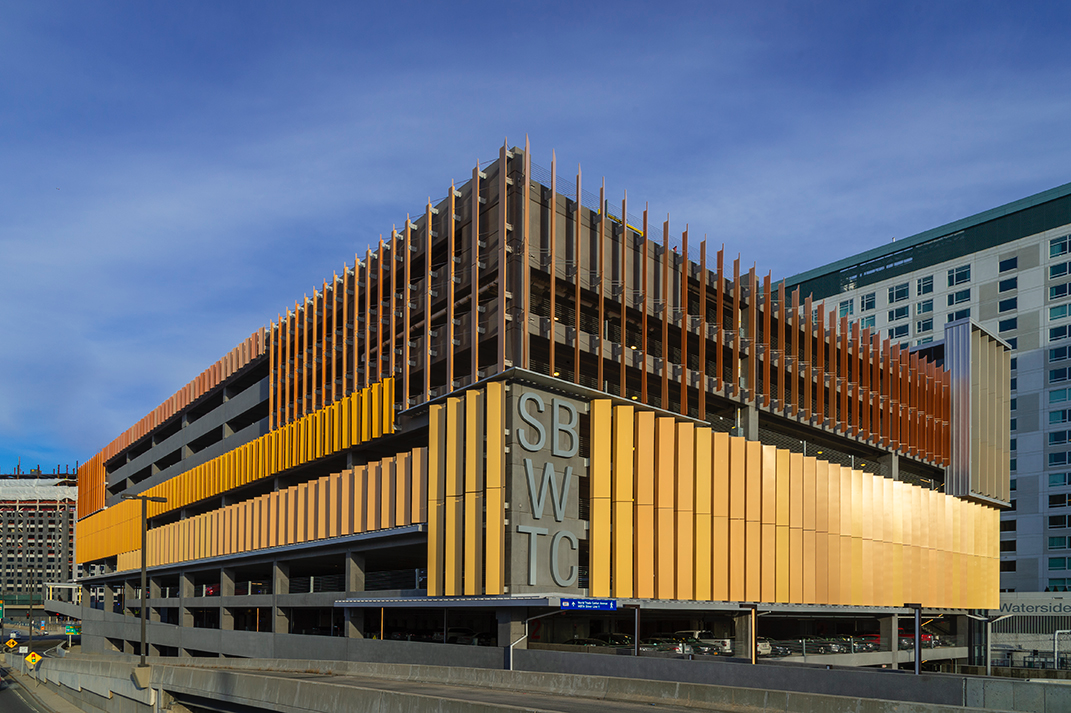- Metalwërks
Design Assist
Design Assist

Design assist: Reshaping the project experience
Architects are not experts in building materials, and sometimes they may specify a product for a particular project element without realizing it may not be the right fit for their design needs. Through the design-assist process, a manufacturer could fill this knowledge gap by providing the project team with everything they need to make the most informed decision possible.
Projects with architectural metal are especially suited for the design-assist process. Widely used in construction, architectural metal can be seen in almost any application imaginable, whether one is working with stainless steel, coated aluminum, or another natural metal. It also has the ability to form shapes and profiles in many ways—whether extruded, formed, or perforated—to achieve an architect’s vision. Metal, however, has a few constraints, sometimes due to an architect’s limited expertise regarding a manufacturer’s fabrication capabilities, and the fact that, like any other product, there are restrictions to working with solid metals, such as size, proportions, and how the building material is affected when it is manipulated. Design assist allows the project team and product manufacturer to collaborate and determine the most suitable approach.
What is design assist?
The traditional design, bid, build workflow is adopted by many in the industry, but it may not be the most effective method to get the job done. Different teams are only brought into the process on an as-needed basis. For example, the general contractor (GC), specialty trades, or product manufacturers are only involved at the bid stage. Design assist can promote collaboration and a shared understanding of what a project entails at an earlier stage itself.
“Design assist has evolved as a procedure to address complexity in the construction industry and how technology has advanced and diversified over the last 30 or 40 years,” says Robert Matthew Noblett, partner, Behnisch Architekten.
In this approach, the architect develops their concept, but then includes the GC, construction manager (CM), contractor, and material supplier in a series of collaborative discussions to ultimately finalize the design. This enables the architect to maintain the project budget and modify expectations or design elements as needed. With design assist, all participants work together with the same key objectives in mind: To develop and maintain a project budget while simultaneously working through the design and establishing the means and methods to turn the concept into a reality. This is also known as a ‘constructability review.’
Case studies: Where design assist was successful
It is advisable to employ design-assist for projects with metal as it is a complex building material. Some projects using this process include the Hartford Hospital Bone and Joint Institute, Connecticut, South Boston Waterfront Transportation Center’s (SBWTC’s) parking garage, Massachusetts, and Pennsylvania State University (PSU) Chemical and Biomedical Engineering Building. Each project is currently in a different phase of completion, but all have followed a similar path. Hartford Hospital was completed in 2015 and SBWTC’s garage was finished in May 2018. At the time of the writing, the PSU project was still under construction/fabrication.
PSU
The design-assist process for the PSU project started early when the architect was developing the schematic designs for the building’s shell. The architect created hand-drawn sketches illustrating the general makeup of the wall construction and identified items such as studs, sheathing, air/vapor (A/V) barriers, and metal panels, but the outline lacked information for panel sizes and joint locations.
The manufacturer worked with the entire team from an early stage and learned several things about the project’s requirements. The architect was looking for an economical zinc façade and solid aluminum plate for accent panels, a soffit at the ground floor exterior, and one for canopy cladding. To keep costs down on the zinc panels, a standard wall system was modified and a custom panel reveal joint mimicking a standard one was also created.
The final appearance included the sightlines and panel reveal joints originally specified by the architect. Thanks to this collaboration, the installation contractor had to use only 50 percent of the total number of zinc panels estimated, saving the owner money on field labor costs and time.
Additionally, the exchange of information was fluid, yet effective. A building information model of the project was created with computer-aided design (CAD) and continuously shared with the entire team.

SBWTC
For SBWTC’s parking garage, the design-assist process was different, illustrating the flexibility of this method. Here, the material supplier was responsible for a highly customized, vertically oriented louver fin for the exterior of a parking garage. The louver fins were custom-fabricated from 5-mm (3/16-in.) thick solid aluminum plate fins cantilevered 1 m (4 ft) off the face of the precast structure.
There are 650 louver fin assemblies coated in 12 different custom colors. Due to these unique and specific details, the design-assist process was very structured and daily conference calls were scheduled over a two-month period until the design was finalized. Discussion topics ranged from establishing the custom colors, design and coordination details, schedule impacts, and budget.
From the beginning, the project architect (Fennick McCredie Architecture) understood the importance of collaborating with a manufacturer to help make the design a reality. As the architect, GC, installer, and manufacturer were able to communicate continuously with one another on this project, the shop drawings were developed simultaneously by the manufacturer and the architect, who was responsible for issuing the construction documents. Subsequently, each team was also familiar with these documents, thereby making the approval process seamless. The fabrication process was also able to begin months earlier when compared to the timeline of the traditional bid schedule. Much of the tasks that occurred during the design-assist phase, such as structural analysis and coordination with adjacent trades, occurred prior to submission of shop drawings. These tasks typically require additional rounds of revisions to shop drawings and re-submissions when operating under the traditional design-build processes.
“When expectations are properly set, design assist can be a good process that allows designs to be quickly and cost-efficiently tailored to the particular strengths of a selected subcontractor or manufacturer,” Noblett adds. “As an inherently collaborative process, you can build a lot of goodwill and a cooperative spirit solving issues early on with the entire team.”

Hartford Hospital Bone and Joint Institute
Unique challenges were present with the Hartford Hospital building. The edifice has a free-flowing curved design with few flat exterior walls. As was the case with PSU and SBWTC, the architect for the Hartford project, Perkins + Will, first prepared their design concept of the façade and then shared it will the rest of the team. Solid 3 mm (118 mils) aluminum plate possesses the ability to maintain a consistent curve, making it the obvious choice to achieve the specified undulations. A rainscreen wall system with dry joinery and a drained and vented cavity behind the wall was also specified. The cut edges of the face plate material in this system are the panels’ edges, and this capability is only achievable with metal plate. Since the hardware is concealed from view, a ‘floating’ visual effect is created.
As with other projects that employed design assist, each had team developed, modified, and coordinated specific details regarding the Hartford Hospital building. Early on in the process, panel system details were developed such that they could be incorporated into contract drawings. To meet design needs, custom aluminum extrusions were created and integrated into the panel design at all of the curtain wall coordination details. Working with the design-assist process meant special tooling could start earlier on these one-of-a-kind elements, such as the extrusion panels that typically have long lead times. Consequently, the manufacturer was able to begin the material procurement and production process earlier, saving time and money.
Results
Each of these three projects was a success as a result of the design-assist process. Information was exchanged efficiently and in a timely fashion. Every team member understood and had budget, design, and schedule goals at their fingertips, and at all stages, details were shared and discussed amongst those involved. There was consistent sharing of information and transmission of ideas. This meant all the stakeholders could quickly determine how each idea had the potential to affect the project either positively or negatively and make informed, well-rounded decisions to everyone’s benefit.